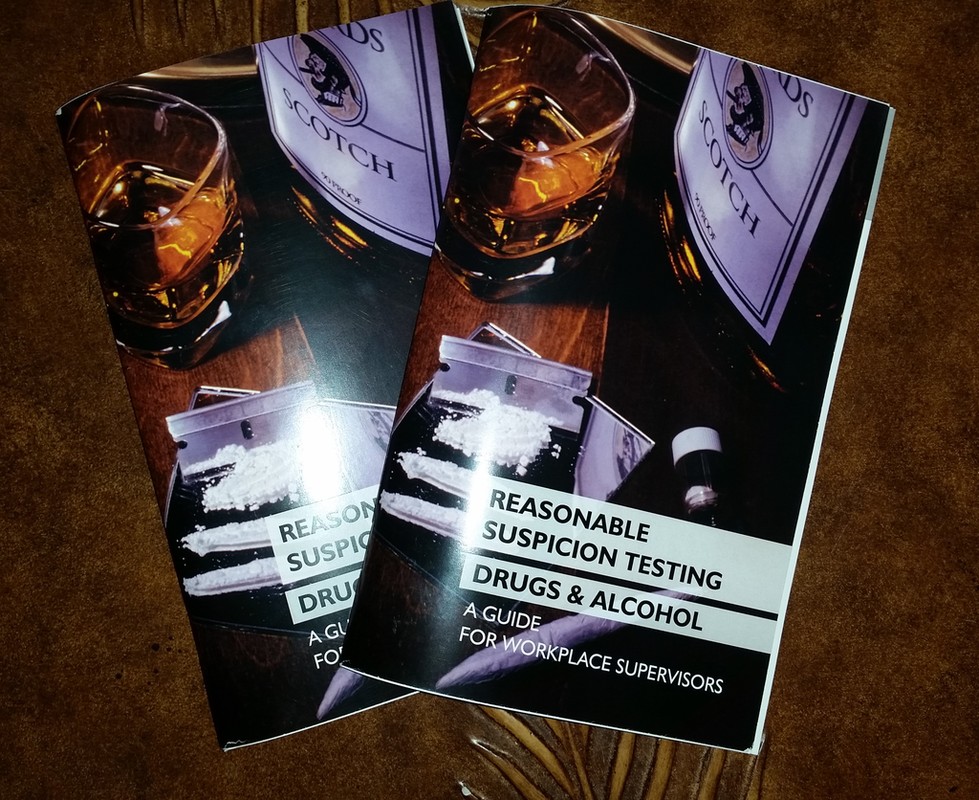>>>Enjoy this short preview of the 69 page REASONABLE SUSPICION TESTING – DRUGS & ALCOHOL – A GUIDE FOR WORKPLACE SUPERVISORS
>>>
INTRODUCTION TO SUPERVISOR TRAINING FOR REASONABLE SUSPICION TESTING
When a worker is impaired by the use of drugs or alcohol, he or she threatens the safety and well-being of everyone at a worksite. While it is the responsibility of every employee to work drug-free, supervisors can be the first line of defense by taking appropriate action when a worker may be impaired.
It is clear that supervisor training is important for many reasons, whether it be to maintain a productive workplace or avoid unnecessary legal problems. Supervisor training emphasizes how to determine reasonable suspicion, detect and document signs of substance or alcohol abuse, and confront an individual who may be under the influence.
You might be surprised that when co-workers become aware that their supervisor has completed a comprehensive training program for reasonable suspicion determinations, they think twice about coming to work in a condition that could compromise their employment. Invest your time to become a trained supervisor when it comes to reasonable suspicion determinations.
There are many parts to your job as a supervisor. Training is critical to your success as a supervisor and you have received various trainings to help you to succeed. Drug and alcohol abuse are a part of life at home and in the workplace. You are on the front line for your company and your employer is counting on you.
A part of your responsibility is to help keep your workplace safe and productive. Helping to prevent the illegal use of drugs and abuse of alcohol is one way to work towards a safe and productive workplace. This guide is all about safety and providing you information and tools to help keep your workplace drug free.
>> Purchase Your Full Guide to Reasonable Suspicion Testing <<
Drug and alcohol abusers can be very disruptive and costly to the workplace. Having direct policies and procedures in place to deal with these issues as they arise will ensure these costs do not get out of hand. Your company is striving to maintain a drug-free workplace. As a supervisor, your assistance is needed. So what exactly is a drug-free workplace?
Best practices for a comprehensive drug-free workplace include a program consisting of five components of:
- Written Drug-Free Workplace Policy
- Employee Education
- Supervisor Training
- Access to Employee Assistance Programs (EAP)
- Drug & Alcohol Testing
It is important to review each of these components.
WRITTEN DRUG-FREE WORKPLACE POLICY
A clearly written policy forms the foundation of a drug-free workplace program. The policy should provide written details of the who, what, where, when and how of the drug-free workplace program. It should include details of the drug and alcohol testing and an appeals process. Of primary importance, the policy should outline the consequences for violating the policy.
If your company has a written drug-free workplace policy, it is your responsibility to read it over carefully. You should be able to articulate a general summary of the drug-free workplace to employees that you supervise. If your company does not have a written drug-free workplace program, it is recommended that you encourage your management team to consider a written drug-free workplace program policy. This will help to deter drug use and alcohol use and keep your workplace safe, secure and productive.
EMPLOYEE EDUCATION
Everyone in the organization needs information about the problems associated with substance misuse. The harmful effects of drug use and alcohol abuse will have far-reaching effects. Employee education will provide details of the company policies on substance use to employees.
A good employee education program can reinforce healthy attitudes and behaviors and deepens awareness on how substance misuse can affect employee health and employment. Best practices for employee education include a program with the following objectives:
- The requirements of the companies drug-free workplace policy.
- The prevalence of alcohol and drug abuse and their impact on the workplace.
- How to recognize the connection between poor performance and alcohol and/or drug abuse.
- The progression of the disease of alcohol and drug addiction.
- What types of assistance may be available
SUPERVISOR TRAINING
Reading this guide is a part of your supervisor training. Training for supervisors helps maximize the effectiveness of the drug-free workplace policy and program. Supervisors should be well-informed about the company drug-free workplace policy and about harmful effects of drugs and alcohol. It is important that you are trained on how to document potential problems in a fair and systematic manner, honor confidentiality, and refer employees to appropriate services. Supervisors may also need training on how to help employees reintegrate into the workplace after receiving services. It is difficult to require an employee to a reasonable suspicion drug or alcohol test, training makes it more comfortable to make these determinations.
ACCESS TO EMPLOYEE ASSISTANCE PROGRAMS (EAP)
Employee assistance programs (EAPs) are designed to help employees with personal problems that may affect their job performance. Drug and alcohol abuse will affect job performance and safety. Many companies provide employee assistance through their health insurance programs.
Find out how your company provides employee assistance. For small companies, it may be just a resource provided to employees on where to get help including local drug-free workplace coalitions or other community-based groups may be able to provide assistance. A great resource is provided by the United States Government through the Substance Abuse and Mental Health Services Administration (SAMHSA). They provide a Drug-Free Workplace helpline (1.800.WORKPLACE) as a resource.
Your company may, but is not required to, provide financial assistance for employees seeking EAP services.
DRUG AND ALCOHOL TESTING
Drug testing is one way to protect your workplace from the negative effects of substance misuse. It can improve workplace safety and reduce costs from misuse of alcohol and other drugs in the workplace. A drug-testing program can also deter employees from coming to work unfit for duty.
Any workplace drug-testing program should comply with applicable local, state, and federal laws. Both federal and non-federal workplaces may have drug testing programs in place. The company’s written drug-free workplace policy should outline when drug testing is required.
Typically drug testing is required for:
- Pre-employment
- Reasonable Suspicion
- Post Accident
- Return to Duty
- Follow Up
- Random Testing
- Fit for Duty Testing
Today drug testing is conducted using urine, oral fluid and/or hair specimens. Alcohol testing is conducted using breath, oral fluid or blood.
As a supervisor, you play a significant role in an effective drug-free workplace program. Part of your job is to help ensure a safe and productive workplace. In a drug-free workplace, this may include recognizing the signs and symptoms of substance abuse, overseeing selection of individuals to undergo drug testing, referring those in need to rehabilitative services, and communicating the details of a drug-free policy to employees.
Well-trained supervisors will make a significant difference in establishing and maintaining a drug-free workplace program that produces results. Untrained and uninformed supervisors could lead too redundant, unnecessary, and costly mistakes. More importantly, they could produce opportunities for legal confrontations from mistreated employees.
SUPERVISOR RESPONSIBILITIES WITHIN THE DRUG FREE WORKPLACE
By reading this guide you will become familiar with important information you need to improve the productivity of your staff and protect their health and safety by tackling problems that may arise from alcohol and other drug abuse at your worksite.
This guide is designed to make your job easier. It can be scary and tough to think about addressing alcohol and other drug use among the people you work with. But you don’t need to be scared, and you don’t have to be tough. Addressing alcohol and other drug abuse in the workplace is first and foremost a conduct and performance issue—an employee who uses or abuses alcohol or other drugs on the job may at some point be an employee whose performance goes downhill. You will see it—and this guide tells you how to deal with what you see.
As a supervisor, you have three main responsibilities within a drug-free workplace program:
- Know Your Organization’s Policy
Review your organization’s written drug-free workplace policy. If you don’t have a copy, ask your employer for one. Become familiar with what the policy permits and prohibits and the penalties for violating the policy. - Be Prepared to Explain the Policy to Employees
As a supervisor, you may be asked to explain the drug-free workplace policy to other employees. Be prepared to answer questions. Most of your employees will welcome a drug-free workplace program, but they will all have questions in the beginning. - Know Your Role
As a supervisor, you are in a unique position to play a major part in a successful drug-free workplace program. You will need to know how to identify and address employee job performance problems. Always keep in mind that while some problems may be related to alcohol and other drugs, others are not.
As a supervisor, your role is to observe and help improve employee job performance, to document work problems and successes, and to effectively implement your organization’s policies and programs.
You are not expected to diagnose alcohol or other drug abuse or to provide treatment or counseling services to employees with job performance problems. Rather, your role is to conduct evaluations of job performance problems.
THE GUIDE ALSO CONTAINS SUPERVISOR SCENARIOS
Scenario Examples:
Employee Appear to be Quite Sleepy and Just out of it
Our employee, Jackie came back from lunch with the smell of alcohol. She appeared to be quite sleepy and just out of it. I had another supervisor to confirm what I was seeing. The other supervisor, Kim, wondered if this was a medical issue, especially because we smelled the alcohol but it did not appear to be from the breath.
We proceeded to have a conversation with Jackie and observed the situation looking for more signs and symptoms, such as motor skills, cognitive engagement, etc. Without our request, she indicated that she was diabetic and therefore we now know this might be the source since diabetics sometimes the sugar ferments.
When someone indicates they are on medications or has a medical condition, we still proceed to the testing. In the end, the test result will hold the answers. The Medical Review Officer or Breath Alcohol Technician analyzes the results. “Trust, but verify” It is the supervisor’s duty to stay the course.
Employee Slurring his Words and was not Interested in the Customer
Paul is a reservation agent for a hotel and can work from home. The company has a mystery shopper program whereby the caller is posing as a customer to ensure quality and great service. On this day, David was the mystery shopper and called Paul. As always, the call may be recorded. On this day, the mystery shopper immediately noticed Paul was slurring his words and was not interested in the caller. He was impatient, loud and rude.
David tried to lighten the conversation; however, Paul was not interested. Since the call was recorded, David immediately sent the recorded call to Nancy who is Paul’s supervisor. Nancy listened to the call and was immediately concerned so she called Paul and he was even more belligerent and barely coherent.
What’s next in this scenario? Purchase the Guide to find out

